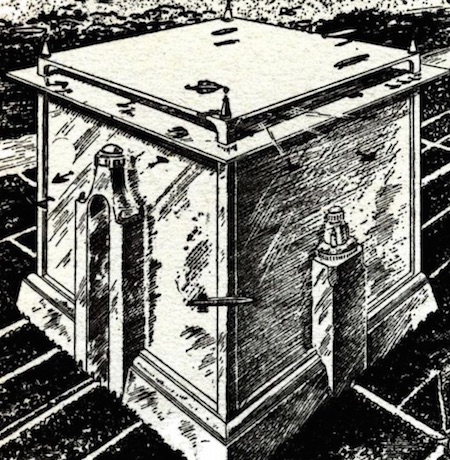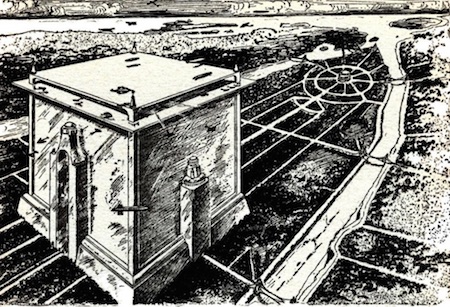Science Fiction
Dictionary
A B C D E F G H I J K L M N O P Q R S T U V W X Y Z
Latest By
Category:
Armor
Artificial
Intelligence
Biology
Clothing
Communication
Computers
Culture
Data Storage
Displays
Engineering
Entertainment
Food
Input Devices
Lifestyle
Living Space
Manufacturing
Material
Media
Medical
Miscellaneous
Robotics
Security
Space Tech
Spacecraft
Surveillance
Transportation
Travel
Vehicle
Virtual
Person
Warfare
Weapon
Work
"Beyond a thousand years from now humans are not quite recognizably human, and I have trouble finding characters."
- Larry Niven
| Cubic City | ||
| A city contained in a single, immense building. |
| "Two miles wide, two miles long, and two miles high is eight cubic miles. Eight floors to the hundred feet or four hundred to the mile give three thousand two hundred square miles of floor space. This is as large as an ancient city forty miles long and twenty wide, covered solidly with houses four stories high; and no part of it is more than two miles front any other part.”
“Obvious,” answered I, "but not enthusing.” “You do not click it,” shrugged my guide.
 ('The Cubic City' by Reverend Louis Tucker, D.D.) “Try it from another slant,” he said. “We have no traffic problem.” “What is your population ?” I asked. “About eighty millions.” “You are not overcrowded,” I sneered. He took me seriously. "Eight hundred floors,” he said: “about a hundred thousand to a floor. That is twenty-five thousand to the square mile and forty persons to the acre. We give a thousand square feet of floor-space to each. That is enough.” |
| Technovelgy from The Cubic City,
by Louis Tucker, D.D.. Published by Science Wonder Stories in 1929 Additional resources -
|
One of the great features of this design is that it leaves so much of the planet for parkland or other uses. The first of the cubic cities really evolved from existing metropolises.
“What limits the size of your cube to two miles?”
“Air pressure. We find a difference in vertical height of two miles about all anyone can stand. Approximately the same limit is placed by horizontal distance. A mile and back is about as far as it is practical to walk.”
“How many cubic cities have you?”
“Fifty-three in the United States; about three hundred in the world. New York is the second largest.”
“What is the largest? London?”
“Jerusalem. It is the nearest to the centre of land surface of the globe. When the Suez Canal became congested past enlargements we blasted channels to the Mediterranean and Red Sea, made Jordan Valley a salt-water inland lake and the safest harbor in the globe, and internationalized Palestine. The consequent growth in population made a vast cubic city necessary.
“Internationalized?”
“Certainly. The world is governed by a League of Cities.”
“What is the population of the globe?”
“About three billion."
The creator of the modern idea of an arcology, Paolo Soleri, describes his idea this way:
See also this essay on the Future City.
Compare to town in one city from When the Sleeper Wakes (1899) by H.G. Wells, the checker-city from The Star-Roamers (1933) by Edmond Hamilton, the Todos Santos arcology from Oath of Fealty (1981) by Jerry Pournelle and Larry Niven and the terrafoam dorm building from Manna (2002) by Marshall Brain.
The growing population overtook them all and clogged them. Yet inside the great buildings which continued to grow larger, there was no congestion, because there was no need of lateral transportation. Everything on any one floor was within easy walk of everything else. Men took an elevator to whatever floor they wanted, then walked to their destinations. Therefore each building tended to be more complete in itself, containing everything but sleeping quarters. At last it became economical to add a floor or two and give janitors, shopgirls, elevator boys, repair men, and such persons dormitories in the building. The custom grew until half the city was housed in the same buildings in which it worked; but since, by that time, the population had more than doubled, this did not ease congestion in the streets. Some help was gained by throwing bridges from building to building; but these became congested too. Bridges were thrown then from every floor of every building and so the cubic city was evolved. The rest was detail."

('The Cubic City' by Reverend Louis Tucker, D.D.)
...a highly integrated and compact three-dimensional urban form that is the opposite of urban sprawl with its inherently wasteful consumption of land, energy resources and time, and tendency to isolate people from each other and the community....The multi-use nature of arcology design would put living, working, and public spaces within easy reach of each other and walking would be the main form of transportation within the city.
Comment/Join this discussion ( 0 ) | RSS/XML | Blog This |
Additional
resources:
More Ideas
and Technology from The Cubic City
More Ideas
and Technology by Louis Tucker, D.D.
Tech news articles related to The Cubic City
Tech news articles related to works by Louis Tucker, D.D.
Cubic City-related
news articles:
- Sky City's 220 Stories Are Go
- Humans Could Take Up A LOT Less Space
- Vast Apartment Living Will Get Even More Vast
| Amazon Will Send You Heinlein's Knockdown Cabin |
| Elegant Bivouac Shelter Produces Water And Electricity |
| AI-THu Shapeshifting Transformer Home |
| With Mycotecture, We'll Just Grow The Space Habitats We Need |
Want to Contribute an
Item?
It's easy:
Get the name of the item, a
quote, the book's name and the author's name, and Add
it here.
| <Previous | Next> |
|
|
|
Technovelgy (that's tech-novel-gee!) is devoted to the creative science inventions and ideas of sf authors. Look for the Invention Category that interests you, the Glossary, the Science Fiction Invention Timeline, or see what's New.
|
Science Fiction
Timeline
1600-1899
1900-1939
1940's 1950's
1960's 1970's
1980's 1990's
2000's 2010's
"The robot solemnly hit a ball against the wall, picked it up and teed it, hit it again, over and again...'
'There was a wall ahead... It was riddled with holes that were the mouths of tunnels.'
'...support the interior human structure against Jupiter’s pull.'
'Anything larger than a BB shot it picked up and placed in a tray...'
'The German chemists have discovered how to supply the needed elements in compact, undiluted form...'
'Compounds devised by the biochemists for the rapid building of bone...'
'The car faltered as the external command came to brake...'
'It is about the size and shape of a kitchen stool, gyro-stabilized...'
